By Jeffrey A. Rendall; Photos By Jeffrey A. Rendall
WOODBRIDGE, VA – Anyone who’s ever picked up a golf club and earnestly tried to golf a dimpled white ball into that tiny little hole knows the game is frustrating. It’s the thrill of the chase that keeps golfers going back, time and time again to try and achieve perfection. The last thing we need when playing the game is a hassle at the course.
Therefore, it’s the responsibility of the folks at the club to try and squelch that natural frustration, to turn it into something positive. The minds at Old Hickory Golf Club (in Woodbridge, Virginia) recognize this, and they’re doing something about it: “When we opened Raspberry Falls (in Leesburg), we sort of pioneered the ‘Member For a Day’ experience. We brought the same service philosophy to Old Hickory,” said Steve Clark, the club’s Head Golf Professional.
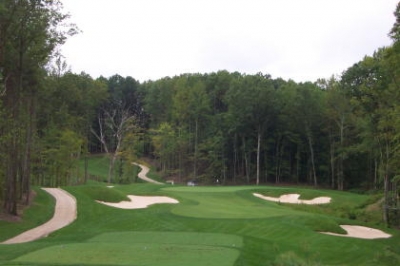 |
| Old Hickory's 217 yard, par three 5th hole. Quite an attractive setting. |
Clark continues, “Our thinking is, when you get to a golf course, you’re excited -- and if you don’t know where to go, where to put your bag, where to check in, then excitement turns to frustration. So, we try to combat that feeling, from the moment you arrive to the moment you leave – we’ll have someone helping get you where you need to go. Players usually show up in a good mood, and we aim to keep them there.”
The beauty and setting of the golf facility at Old Hickory greatly aids in Clark and the staff’s quest to keep you in the right frame of mind. The golf course opened in July of 2003, helping to fill a void in the upscale golf market in central Prince William County. There’s a healthy abundance of championship caliber golf layouts in the surrounding metropolitan Washington DC area, yet for the considerable population in this neck of the woods, you’d need to drive a bit to find it.
Clark says locations was part of the motivation for building Old Hickory: “I call it a ‘St. Andrews’ type of idea, where you can be a member of St. Andrews if you live over in Scotland – but if you’re only visiting the country, you can still play there. Our owners look at building golf courses that’ll serve as attractions for an area. People will come there just to play it. So, typically, our group’s golf courses are as nice or nicer than most private clubs.”
As alluded to above, Old Hickory is the sister course to Raspberry Falls (and part of the Raspberry Golf Trail), which was one of the first entries in the DC area’s upscale golf building boom in the mid-nineties. Raspberry is known for its old country look, with stacked sod bunkers, and links-like feel. It’s also recognized for its outstanding customer service, with uniformed cart attendants and an exquisitely accented clubhouse. The fact it’s in northern Virginia’s hunt country doesn’t hurt – and as a result, it’s been wildly popular and successful.
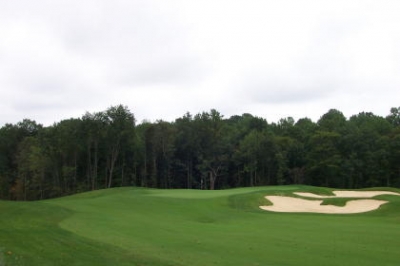 |
| At 446 yards, the par four 11th hole will challenge your ability to hit a long ball. And if you're in the sand near the green, you'd better bring your bunker skills, too. |
Raspberry Falls’ ownership group wanted that same type of achievement further south in Woodbridge. For that reason, they brought in golf architect Tim Freeland, who served as Senior Design Associate under Gary Player at Raspberry Falls. Now out on his own, Freeland certainly proved to be the right man for the job -- even if by his own admission, Old Hickory bears little resemblance to its sibling to the north.
“We knew going in that Old Hickory would turn out completely different than Raspberry Falls, because the land and vegetation were very dissimilar. Old Hickory has the tall hardwoods, and Raspberry’s out on open plains. But our goal was to create the same type of ‘Country Club For A Day’ mentality. I think we achieved that, because Old Hickory’s a beautiful but fair golf course,” Freeland said.
He continues, “I was instantly impressed by the beautiful, natural setting. Old Hickory’s two nines are bisected by Beaver Creek, which is a beautiful, protected environmental area. So, you really get the feeling you’re playing golf out in the woods, rather than in a housing development.”
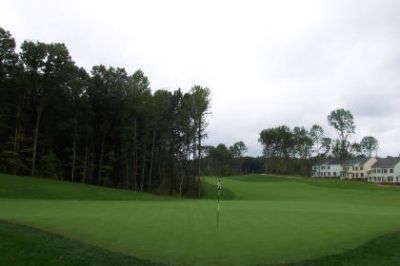 |
| The par five 6th hole has a unique shape, calling for a draw off the tee and a fade into the green -- if you want to try and reach it in two. |
Old Hickory is very beautiful, and fair – it’s one of those courses where you’ll see a severe decline in slope (no pun intended) rating as you move forward from tee box to tee box. The back tees measure 7077 yards and carry a 145 slope, while the white tees, where most average players tee it up, are just under 6000 yards and sloped at 131. That’s quite a steep change in elevation, if you’ll pardon the expression.
Clark expands on the idea: “We want people to have fun, so what we really tried to do conceptually, was design a golf course that didn’t suit any one particular type of game. I often play with one of our starters who’s a senior player and a five handicap, and this course, because of the way the natural undulations were incorporated into the layout, really benefits someone like him. He’ll hit it about 220 yards off the tee with a little draw, and if you place it in the right spots, the slopes will give you a lot of extra roll. In that sense, the course plays a lot like those in Britain or someplace like Shinnecock Hills.”
Freeland echoes Clark’s thinking: “From the back tees, you’re talking about professionals and low single-digit handicap players – our goal was to force these players to work the ball in both directions. Conversely, the average player from the forward tees, they’re just hitting the ball down the middle of the fairway. Some holes call for a draw shot, others a fade – and by changing angles and tees (and positioning trees), and tightening fairways for better players based on where their landing area is, it helps keep the course flexible.”
“It’s difficult from the back, and fair from the front,” Freeland said.
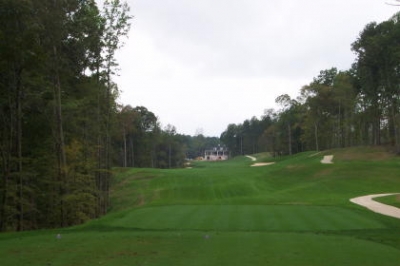 |
| You won't feel cheated on the 18th hole. From the back tees, there's 626 yards of Virginia real estate between you and the putting surface. |
Another thing you’ll immediately notice about Old Hickory is the bunkering style. Simply put, it’s dramatic and bold. After crafting the stacked sod bunkers at Raspberry Falls, Freeland’s furthered his reputation as a sand bunker guru at Old Hickory.
“If I was asked for the one thing that really sets us apart, it’s the bunkers,” Clark said. “They’re very well placed off the tee, and it’s pretty tough to go through a round without having to hit one or two fairway bunker shots on the golf course – which when you think about it, is something you don’t often face. That’s a shot that people don’t usually practice, because it’s not something they’re expecting to see much. But with Freeland’s effective placement of the bunkers, they’re all very much in play. He did a great job of rewarding accuracy versus just plain distance.”
According to Clark, it’s more than just bunker placement, it’s maintenance, too. “Our bunkers are also extensively maintained, and as costs go, that’s a place where courses often cut corners. Freeland is very diligent when he designs bunkers, making sure they drain properly so you have consistency with the sand. Consistency’s where most places go wrong, because if they’re not built right in the first place, you’re already off to a bad start.”
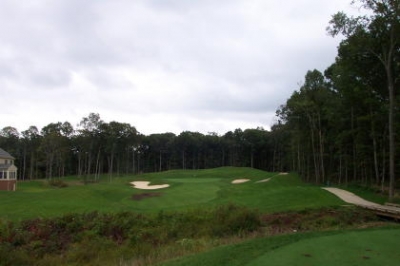 |
| The par three 7th hole is the second in a fine set of one shotters at Old Hickory. |
Speaking of starts, you’ll also certainly note that Old Hickory winds in and around a burgeoning housing community. It’s a poorly kept secret that people desire homes with golf course views. But there’s a difference between having houses surrounding a golf course, and having homes on the golf course.
Here, Freeland says the houses are definitely of the former variety: “Knowing from the start that this was a golf course community, we tried very hard to make sure the homes didn’t impact the golf, as well as ensuring the golf didn’t impact the homes. There are occasions during the route where you’ll notice the housing, but, nowhere is it uncomfortable to the player – that’s our goal.”
And oddly enough, the presence of the houses might actually help your score: “If you’ll notice, almost every view from the home sites looks down on the golf course, which creates a comfortable feeling for both homeowners and players. The players feel like they’re contained within the terrain, rather than having an errant shot kick further out-of-bounds, or towards the home sites. In essence, the ball will bounce back onto the golf course,” Freeland surmised.
He’s right – the houses are far enough removed where most wayward missiles will fall without causing destruction. It helps alleviate the guilt some of us have felt in the past when contributing un-requested souvenirs to the unsuspecting (and unfortunate) surrounding residents.
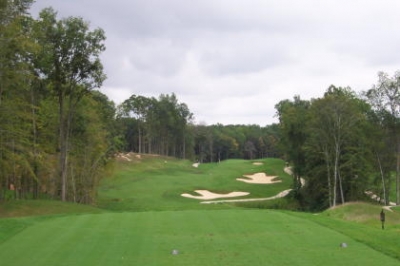 |
| Avoidance of bunkers suggests the correct tee shot on the par four 16th hole. |
Hole highlights include number three, a 565 yard par five where you’ll possibly be able to take advantage of the slopes mentioned above off the tee to get some added distance, if you can work the ball right to left. The green’s potentially reachable in two if you’re very long off the tee, though you’ll be firing slightly uphill to a well-protected green. The try is somewhat encouraged, however, as Freeland provided generous landing zones on either side of the green – but then you’ve got to get up and down.
Clark says it’s those little short shots that make the course fun: “I think the 60 degree wedge has kind of hurt the game, because whenever you get around the green, you automatically think you should be using it. Here, we’ve got some large chipping areas, where you’re using everything from a five-iron to that 60 degree wedge – then you’ve got little tiers to hit into or putt off of. It’s not only more challenging, it’s more enjoyable.”
You’ll certainly get to use those skills on Old Hickory’s par threes, quite a fine lot, the bunch of ‘em. “I just couldn’t be happier with the par threes out there. They all sit in real nice, and the bunkering really makes them visually stunning. Seventeen reminds me a bit of the Golden Horseshoe (which many people set as the standard for beautiful par threes). Five is also a great par three, with so much variety to it, as does seven. With the different pin positions, they’ll play different every time,” Clark said.
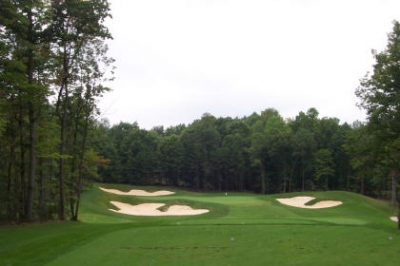 |
| The par three 13th is one of Freeland's favorites. The green is very large, so many types of shots are potentially testable. |
I can only add, ‘ditto’ – they’re all nice to look at and fun to play.
As a final note, just as with Raspberry Falls, the cart attendants are dressed in ‘theme’ apparel, to contribute to the Old Hickory atmosphere. Clark said they’re trying to set a very old-style, traditional theme, and the uniforms go along with it. I can personally say, the staff is very upbeat, too.
So you could conclusively say, a visit to Old Hickory won’t add to golf’s frustrating nature. With such a beautiful setting, you’ll have to work hard to feel stress – or, we’ll just leave that up to your golf game to provide, instead.
Details:
Old Hickory Golf Club
11921 Chanceford Rd.
Woodbridge, VA 22192
Phone: (703) 580-9000
Website: www.golfoldhickory.com
Course Architect: Tim Freeland
Director of Golf Operations: Steve Clark, PGA
Superintendent: Dave Horton
Tees/Yardage/Slope/Rating
Black 7077/145 74.5
Gold 6615/140 72.1
White 5980/131 69.1 131/75.1 (W)
Raspberry 5143/125 70.8
Rates:
Check the website for current rates.
Raspberry Golf Trail: http://www.raspberrygolftrail.com/
| Related Links | Comments on this article? | |
|
Maryland National Golf Club Hollow Creek Golf Club Rocky Gap Resort PB Dye Golf Club in Ijamsville Whiskey Creek Golf Club |
E-mail Jeff Rendall, Editor: jrendall@golftheunitedstates.com |











